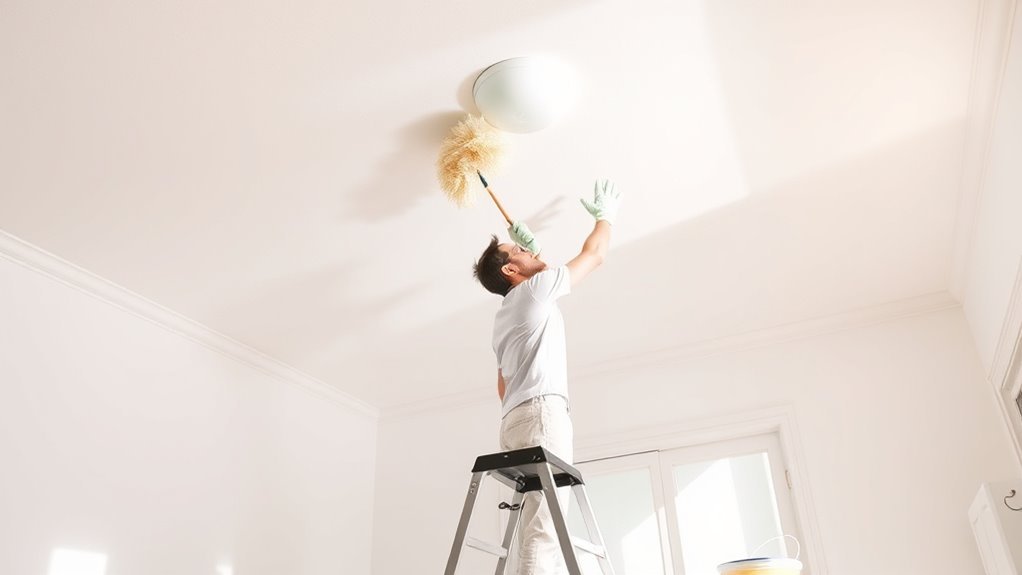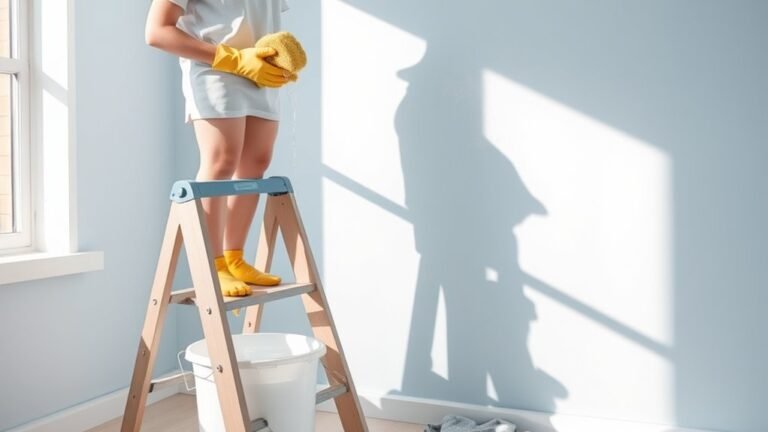How to Clean Your Ceilings Safely
To clean your ceilings safely, start by clearing the area and covering furniture to protect it. Use a sturdy ladder and wear gloves and goggles for safety. Choose gentle cleaning tools like a soft duster or microfiber cloth dampened with mild soapy water. Test a small spot before wiping to avoid damage. Avoid harsh chemicals and excessive moisture to keep your ceiling intact. Keep these steps in mind, and you’ll soon discover how to tackle various ceiling types and stubborn stains effectively.
Tools and Materials Needed for Ceiling Cleaning
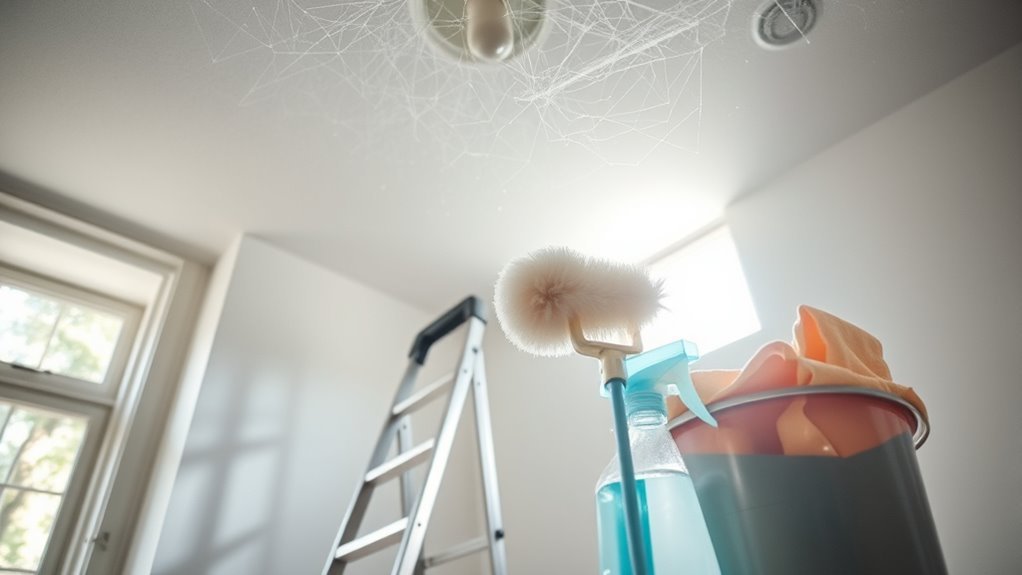
Before you begin cleaning your ceiling, you’ll need to gather the right tools and materials to make the job easier and safer. Start with reliable ceiling tools like an extendable duster or a soft-bristle brush, designed to reach high spots without strain. You’ll also want a sturdy ladder to maintain balance and freedom of movement. Choose gentle cleaning solutions that won’t damage your ceiling’s finish—mild soap mixed with water usually works well. Avoid harsh chemicals to keep your space safe and fresh. Have microfiber cloths ready to wipe away loosened dust and stains. By equipping yourself with the proper ceiling tools and eco-friendly cleaning solutions, you’ll enjoy a smooth, efficient cleaning experience that leaves your ceilings spotless without compromising your independence or safety.
Preparing Your Room for Ceiling Cleaning
To prepare your room for ceiling cleaning, start by clearing the area beneath the ceiling to prevent any damage or mess. Shift furniture away from walls and centralize items to create a spacious work zone. This room arrangement gives you freedom to move and reduces the risk of knocking things over. Next, cover remaining pieces with drop cloths or old sheets for furniture protection. Secure coverings with tape if needed to keep dust and cleaning solutions off your belongings. Remove fragile or valuable items from the vicinity altogether. By organizing your space thoughtfully, you’ll make the cleaning process smoother and protect your belongings without hassle. This preparation sets the stage for efficient, worry-free ceiling cleaning, allowing you to focus on the task without distractions.
Safety Precautions Before You Begin
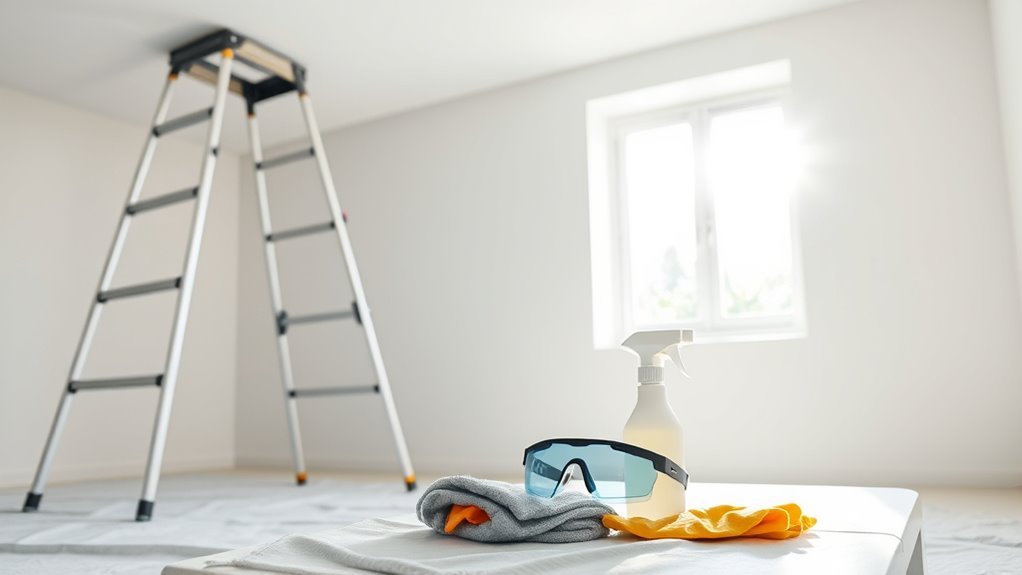
Once your room is set up and your belongings are protected, it’s important to focus on safety to avoid accidents while cleaning your ceiling. You want to keep things smooth and secure, so start by checking your ladder stability—make sure it’s on an even surface and fully opened. Don’t skip wearing protective gear like gloves, goggles, and a mask to shield yourself from dust and debris. Here are three key safety tips before you begin:
- Confirm your ladder is sturdy and locked in place to prevent falls.
- Wear protective gear to keep your skin, eyes, and lungs safe.
- Clear the area around the ladder so you can move freely without tripping hazards.
Stay safe and enjoy the freedom of a clean ceiling!
How to Remove Dust and Cobwebs From Ceilings
Three simple tools will make removing dust and cobwebs from your ceiling quick and easy: a microfiber duster, an extendable pole, and a vacuum with a brush attachment. Start with gentle ceiling dusting to avoid damage, then target cobweb removal in corners and light fixtures. Use the extendable pole to reach high spots safely.
| Tool | Purpose | Tips |
|---|---|---|
| Microfiber Duster | Ceiling dusting | Light, broad strokes |
| Extendable Pole | Reach high areas | Secure attachment |
| Vacuum Brush | Cobweb removal | Low suction setting |
| Ladder (optional) | Access tricky spots | Confirm stability |
| Soft Cloth | Final touch-ups | Avoid wetting ceiling |
This approach gives you freedom from dust and webs without hassle or risk.
Techniques for Cleaning Painted Ceilings
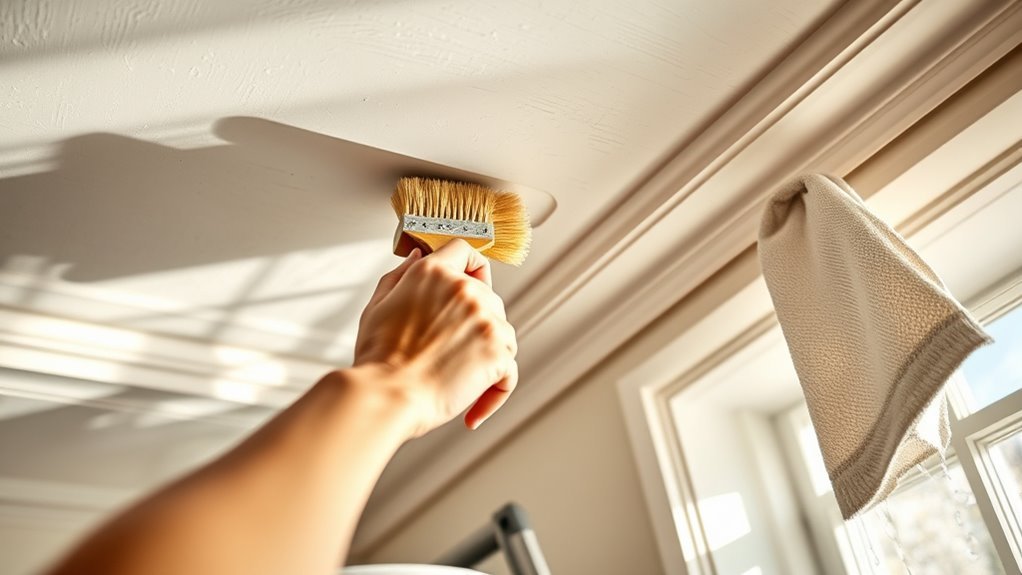
Cleaning painted ceilings requires a gentle touch to protect the finish while removing dirt and stains. To keep your ceilings looking fresh without damage, choose the right cleaning methods that suit your paint type. Here’s how you can approach ceiling maintenance effectively:
- Use a soft sponge or microfiber cloth dampened with mild soapy water to wipe away grime without scrubbing harshly.
- Test a small, hidden area first to guarantee the paint won’t peel or discolor.
- Avoid excessive moisture; wring out cloths well to prevent water damage.
Cleaning Textured and Popcorn Ceilings
While painted ceilings can be gently wiped down, textured and popcorn ceilings need a different approach to avoid damaging their unique surfaces. When cleaning these, you’ll want to embrace specific textured ceiling techniques that protect the delicate finish. Start by using a soft brush or a vacuum with a brush attachment to remove dust without dislodging the texture. Avoid soaking the surface—too much moisture can cause the popcorn to crumble or peel. For popcorn ceiling care, lightly mist a cloth with water or a mild cleaner and gently dab spots; never scrub. By following these careful steps, you maintain your ceiling’s character while enjoying the freedom to keep your space fresh and inviting without risking damage.
Removing Stains and Spots Safely
Even if you’re careful, ceilings can develop stains or spots over time that need gentle attention. For effective stain removal without damaging your ceiling, you want to approach spot treatment with care and precision. Here’s how to handle it:
- Use a soft cloth dipped in a mild detergent solution to gently dab the stained area.
- Avoid scrubbing vigorously; instead, blot the spot to lift it without spreading or embedding the stain.
- Test any cleaner in a small, hidden area first to verify it won’t discolor or harm your ceiling finish.
Preventing Future Ceiling Dirt and Damage
Though it’s important to clean your ceiling regularly, taking steps to prevent dirt and damage in the first place will save you time and effort down the road. Embrace preventive maintenance by addressing common issues like leaks, mold, or excess humidity early. Make sure your home is well-ventilated to reduce moisture buildup, which deteriorates ceiling surfaces. Regularly inspect your ceiling for cracks or peeling paint and fix them promptly to avoid bigger problems. Using ceiling fans or air purifiers can also help minimize dust accumulation, keeping your ceiling cleaner longer. By committing to consistent ceiling care, you’re not just preserving your space—you’re maintaining the freedom to enjoy a fresh, damage-free environment without constant worry or heavy cleaning sessions.
Frequently Asked Questions
Can I Use Bleach to Clean Mold on Ceilings?
Thinking about using bleach to tackle mold on your ceilings? While bleach can kill mold on non-porous surfaces, it’s not the best for mold removal on ceilings since it may damage paint or drywall. Why not choose bleach alternatives like vinegar or baking soda? They’re safer, eco-friendly, and still effective. You deserve freedom from harsh chemicals, so opt for gentle solutions that keep your space clean without compromising your health or the environment.
How Often Should Ceilings Be Professionally Cleaned?
You might wonder about the ideal ceiling maintenance frequency. Generally, getting your ceilings professionally cleaned every 3 to 5 years keeps them fresh and prevents buildup. Professional cleaning benefits include thorough dust and stain removal you might struggle with on your own, plus it helps maintain your home’s air quality. By sticking to this schedule, you’re freeing yourself from constant worry and ensuring your ceilings stay in great shape effortlessly.
Are Steam Cleaners Safe for Ceiling Cleaning?
Ever wonder if steam cleaners are safe for ceiling cleaning? They actually offer great benefits, like killing germs and loosening dirt without harsh chemicals. But you’ve got to be careful—too much moisture can damage paint or drywall. For the best results, follow ceiling cleaning tips like testing a small spot first and keeping your steam cleaner at a distance. That way, you enjoy a fresh ceiling without risking damage.
What Is the Best Way to Clean Ceiling Fans?
When it comes to ceiling fan maintenance, you’ll want to keep things simple and effective. Start by turning off the fan and using a microfiber cloth or a duster with an extendable handle as your cleaning tools. Don’t forget a pillowcase to trap dust easily—just slip it over each blade and wipe. This way, you keep your fan spinning freely and dust-free without much hassle or mess.
Can Ceiling Cleaning Improve Indoor Air Quality?
Did you know indoor air can be up to five times more polluted than outdoor air? When you clean your ceilings, you’re tackling dust accumulation that traps airborne pollutants, which can seriously impact your breathing space. By clearing that buildup, you’re freeing yourself from hidden irritants and creating a fresher, healthier environment. It’s a simple step that boosts your indoor air quality, giving you the freedom to breathe easy and live comfortably.
